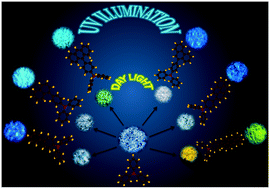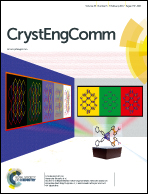Crystalline triphenylamine substituted arenes: solid state packing and luminescence properties†
Abstract
The crystal packing and solid state photophysical properties of twisted propeller-shaped triphenylamine (T) incorporated aromatic hydrocarbons [ArT where Ar = benzene (Ph), naphthalene (N), anthracene (A), phenanthrene (Phe), pyrene (Py) and perylene (Pe)] are investigated. The qualitative crystal structure and quantum theory of atoms-in-molecules (QTAIM) analyses revealed the dominant role of intermolecular C–H⋯C interactions in governing the three-dimensional arrangement in ArT crystals. Hirshfeld surface analyses revealed that the triphenylamine-substituted arene (ArT) crystals possess a herringbone motif with ρ (%C–H⋯C/%C⋯C) values varying from 10.4 in PeT to 101.2 in AT. A blue shift of ca. 10–28 nm in the emission maxima for PhT, NT, AT, PheT and PyT is observed in the solid state in comparison to that in dichloromethane while the solid state emission maxima is red shifted (ca. 25–71 nm) compared to that in hexane. A 2.40-fold enhancement in the quantum yield of AT is observed in the solid state relative to the solution state (dichloromethane). Solvent polarity dependent absorption and emission measurements of ArT derivatives along with Lippert–Mataga analyses evidenced the presence of charge transfer interactions between Ar and T units. A precise and systematic understanding of the influence of the crystal structure on the photophysical properties is quintessential to achieve highly efficient organic light emitting diodes and other optoelectronic devices in the near future.



 Please wait while we load your content...
Please wait while we load your content...